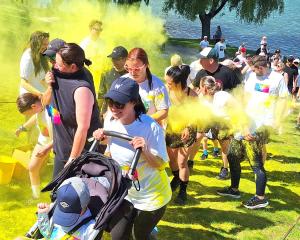A Wanaka property owner has donated $250,000 to the ongoing battle against the lake-choking weed lagarosiphon.
It is unclear whether the man, who wants to remain anonymous, lives in the town.
A condition of the donation, which will be given over five years, is that it be spent eradicating the weed in Paddock Bay, which is near the Glendhu Bay boating and camping area.
Lagarosiphon is an African aquatic weed which establishes and spreads easily, choking waterways. It is believed even a couple of centimetres of the plant, cut by a boat propeller for example, can put down roots.
Work to reduce the amount of weed in the lake began a decade ago and it was announced last week the northern two-thirds of the lake is now clear.
Dave Mole, biosecurity manager at Land Information New Zealand (Linz), which manages the lagarosiphon control work, said, as far as he was aware, it was the first time a member of the public had given to the cause.
''We're extremely grateful. It came totally out of the blue ...
''The community has come to the party.''
Mr Mole said, while the man did not want to be named, he hoped his gesture would encourage other people or organisations to follow suit.
Linz, a Government department, spends $300,000 a year on removing the weed from the lake, boosted by small contributions from the Queenstown Lakes district and Otago regional councils, and the donation would not affect this, Mr Mole said.
''We certainly won't be cutting funding. We can't. We wouldn't.
''This project is dear to our hearts. We've just developed a new 10-year strategy.
''The bottom line is Lake Wanaka is the reservoir.
''Anything that breaks off floats down and ends up in Lake Dunstan and further down the track.
''[The donation] is a significant boost which will accelerate the programme considerably.''
Paddock Bay had responded well to the lagarosiphon control work, which includes - somewhat contentiously - spraying the herbicide Diquat, suction-dredging and hand-weeding, using divers.
Paddock Bay was inundated with the weed when the work began in 2005, but last year was largely clear, other than some big weed beds under the surface, Mr Mole said.
''[The donor] is very impressed with the work over the past few years and wants us to continue to make progress.''
The Otago Daily Times reported last week new lagarosiphon control equipment is being developed. All going according to plan, a ''pulveriser'' - a machine which will mulch the weed into fragments too small to re-grow - will be trialled early next year.
If successful, it would be ''well used and cost-effective'', Mr Mole said.
It was likely herbicide and hand-weeding would also be used to remove the weed from other parts of Lake Wanaka this financial year, including at Glendhu Bay, around Stevenson's Island, Eely Point and at the Roy's Bay boat ramp.
Hand-weeding would continue as necessary in the part of the lake which had already been cleared, Mr Mole said.
Lagarosiphon control work is also due to begin downstream in Lake Dunstan, parts of which are choked with the weed.
Linz also funds weed eradication programmes in Lakes Benmore and Karapiro, and the Rotorua lakes.
by Jessica Maddock













